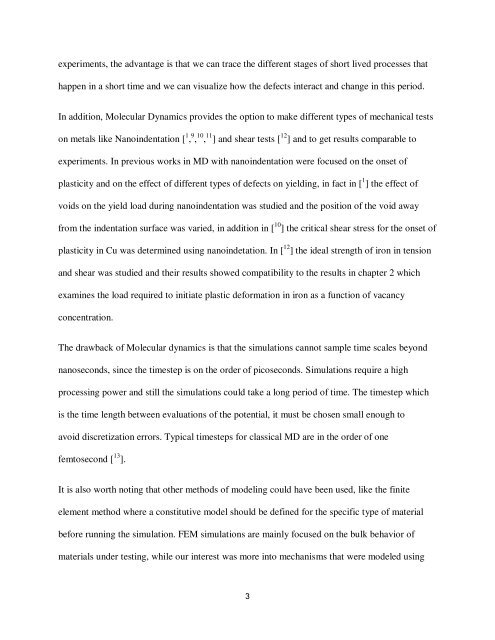DEFECTS IN METALS AND SIMULATION OF MECHANICAL ...
DEFECTS IN METALS AND SIMULATION OF MECHANICAL ...
DEFECTS IN METALS AND SIMULATION OF MECHANICAL ...
You also want an ePaper? Increase the reach of your titles
YUMPU automatically turns print PDFs into web optimized ePapers that Google loves.
experiments, the advantage is that we can trace the different stages of short lived processes that<br />
happen in a short time and we can visualize how the defects interact and change in this period.<br />
In addition, Molecular Dynamics provides the option to make different types of mechanical tests<br />
on metals like Nanoindentation [ 1 , 9 , 10 , 11 ] and shear tests [ 12 ] and to get results comparable to<br />
experiments. In previous works in MD with nanoindentation were focused on the onset of<br />
plasticity and on the effect of different types of defects on yielding, in fact in [ 1 ] the effect of<br />
voids on the yield load during nanoindentation was studied and the position of the void away<br />
from the indentation surface was varied, in addition in [ 10 ] the critical shear stress for the onset of<br />
plasticity in Cu was determined using nanoindetation. In [ 12 ] the ideal strength of iron in tension<br />
and shear was studied and their results showed compatibility to the results in chapter 2 which<br />
examines the load required to initiate plastic deformation in iron as a function of vacancy<br />
concentration.<br />
The drawback of Molecular dynamics is that the simulations cannot sample time scales beyond<br />
nanoseconds, since the timestep is on the order of picoseconds. Simulations require a high<br />
processing power and still the simulations could take a long period of time. The timestep which<br />
is the time length between evaluations of the potential, it must be chosen small enough to<br />
avoid discretization errors. Typical timesteps for classical MD are in the order of one<br />
femtosecond [ 13 ].<br />
It is also worth noting that other methods of modeling could have been used, like the finite<br />
element method where a constitutive model should be defined for the specific type of material<br />
before running the simulation. FEM simulations are mainly focused on the bulk behavior of<br />
materials under testing, while our interest was more into mechanisms that were modeled using<br />
3

















